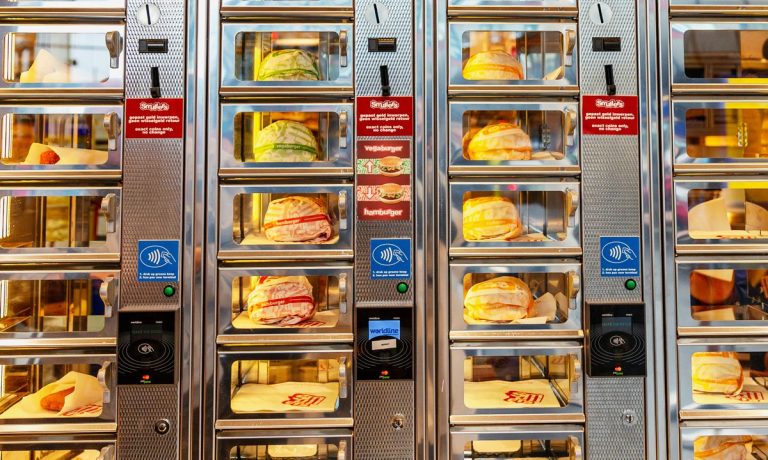As labor challenges have an increasing number of food service operators turning towards automated solutions, businesses in different countries are facing very different landscapes when it comes to consumers’ readiness for new technologies.
Take, for instance, Yo-Kai Express, an autonomous restaurant company with locations in the United States, Japan and Taiwan. Amanda Tsung, the company’s chief operating officer, spoke with PYMNTS about the gap between adoption in Japan, where the company only announced its launch last month, and in the United States, where the company has been for years.
“In Japan, because it is the vending machine Mecca, I do see more participation,” she said. “People are more likely to try it for the first time than compared to the U.S. Like, I saw a 75-year-old man walking up to our machine in Japan and trying it. … I thought that was quite interesting.”
Certainly, the commonness of various technologies varies dramatically from country to country, and consumers’ adoption rate is similarly regionally dependent, according to data PYMNTS’ February study, the 2022 Global Digital Shopping Index, created in collaboration with Cybersource.
Related news: Six Country Study Confirms Mobile Phone Is Modern Shopping’s Must-Have
For instance, the study, which draws from six census-balanced panels of consumers across six key markets totaling over 13,000 and from a survey of 3,000 merchants across these countries, finds that while 81% of merchants in Mexico offer voice-enabled purchasing options, only 54% in the U.S. do the same. Similarly, while 53% of consumers in the United Arab Emirates use Buy Now, Pay Later (BNPL) options, only 28% of those in the United Kingdom do the same.
Advertisement: Scroll to Continue
Granted, research from the 2022 Global Digital Shopping Playbook: U.S. Edition finds that United States businesses tend to be ahead of the curve when it comes to digitization. The study found that, while small- to midium-size businesses (SMBs) across all countries generated 57% of their sales via digital channels, 71% of U.S. SMBs’ sales came through these channels.
Generational Differences
Despite noting quicker adoption in Japan, Tsung stated that consumers across age groups are nonetheless also trying out the technology in the United States.
Older consumers are slower to adopt new food ordering methods, according to data from PYMNTS’ 2021 How We Eat Playbook, created in collaboration with Carat from Fiserv, which drew from a survey of a census-balanced panel of more than 5,200 U.S. adults. The study found that, while 76% of consumers place restaurant orders online for pickup, only 62% of baby boomers and seniors do the same, and while 47% of all consumers order online for delivery, less than half that share (23%) of baby boomers and seniors do the same.
You may also like: 182M Consumers Now Use Digital Channels to Shop and Pay for Food
Ready or Not
While some restaurants are rushing to automate, others are hesitant about fully autonomous, vending machine-style models such as Yo-Kai’s. Tsung recalls “the existing food and beverage operators thinking that they’re just not open to it yet,” adding that these businesses “just can’t wrap their minds around food automation.”
Granted, there is a huge spectrum of automated technologies, and a restaurant may be willing to adopt, say, an automated kitchen assistant without going fully autonomous.
The January edition of PYMNTS’ Main Street Index study, “The Main Street Index: Optimism Amid Inflation Edition,” created in collaboration with Melio, which drew from a survey of 765 Main Street U.S. business owners conducted in the late fall, found that 29% of businesses in the food, entertainment and accommodation segment reported that they are “very” or “extremely” likely to invest in automation/robotization of tasks that currently require manual labor.
See also: Two-Thirds Of US Main Street Businesses Show Optimism Despite Inflation, Economic Uncertainty
The All-Hours Model
While Yo-Kai currently runs its own automated restaurants, the company’s vision of the future includes powering vending machine-style locations for existing restaurants to drive additional sales outside of normal operating hours.
“We can … work with restaurants, bringing their signature dishes onto our platform to be able to be enjoyed wherever there’s a Yo-Kai machine, so this … gives them another revenue stream,” said Tsung.
In that way, the technology resembles what robotics company Tortoise is doing with its Mobile Smart Stores, roving vending machines that aim to provide merchants with the chance to sell more items in new geographic areas and at times when the store is closed.
Read more: Last-Mile Delivery Firm Tortoise Turns to Mobile Vending Machines
Models such as these can be useful, especially as labor constraints have many restaurants closing their doors early, leaving some demand unmet.
“In America, … things close relatively early, and to get anything remotely delicious is very difficult in the middle of the night,” Tsung said, “so I think that we … complement [existing] restaurants quite well.”




